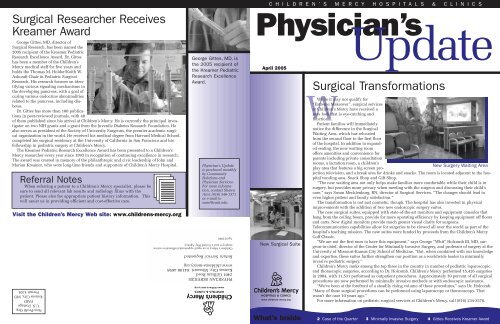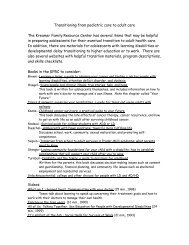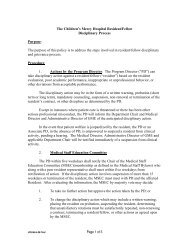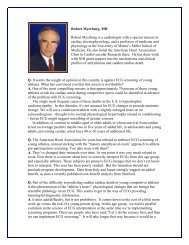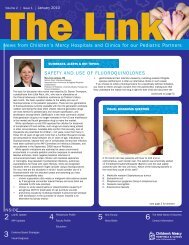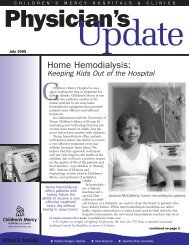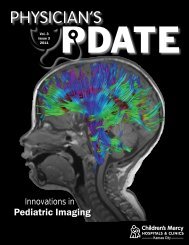Surgical Transformations - Children's Mercy Hospitals and Clinics
Surgical Transformations - Children's Mercy Hospitals and Clinics
Surgical Transformations - Children's Mercy Hospitals and Clinics
- No tags were found...
Create successful ePaper yourself
Turn your PDF publications into a flip-book with our unique Google optimized e-Paper software.
<strong>Surgical</strong> Researcher ReceivesKreamer AwardGeorge Gittes, MD, director of<strong>Surgical</strong> Research, has been named the2005 recipient of the Kreamer PediatricResearch Excellence Award. Dr. Gitteshas been a member of the Children’s<strong>Mercy</strong> medical staff for five years <strong>and</strong>holds the Thomas M. Holder/Keith W.Ashcraft Chair in Pediatric <strong>Surgical</strong>Research. His research focuses on identifyingvarious signaling mechanisms inthe developing pancreas, with a goal ofcuring various endocrine abnormalitiesrelated to the pancreas, including diabetes.Dr. Gittes has more than 180 publicationsin peer-reviewed journals, with 40of them published since his arrival at Children’s <strong>Mercy</strong>. He is currently the principal investigatoron two NIH grants <strong>and</strong> a grant from the Juvenile Diabetes Research Foundation. Healso serves as president of the Society of University Surgeons, the premier academic surgicalorganization in the world. He received his medical degree from Harvard Medical School,completed his surgical residency at the University of California in San Francisco <strong>and</strong> hisfellowship in pediatric surgery at Children’s <strong>Mercy</strong>.The Kreamer Pediatric Research Excellence Award has been presented to a Children’s<strong>Mercy</strong> researcher every year since 1993 in recognition of continuing excellence in research.The award was created in memory of the philanthropic <strong>and</strong> civic leadership of John <strong>and</strong>Marion Kreamer, who were long-time friends <strong>and</strong> supporters of Children’s <strong>Mercy</strong> Hospital.Referral NotesWhen referring a patient to a Children’s <strong>Mercy</strong> specialist, please besure to send all relevant lab results <strong>and</strong> radiology films with thepatient. Please also fax appropriate patient history information. Thiswill assist us in providing efficient <strong>and</strong> cost-effective care.Visit the Children’s <strong>Mercy</strong> Web site: www.childrens-mercy.orgNon-Profit Org.U.S. PostagePAIDKansas City, MOPermit 4301George Gittes, MD, isthe 2005 recipient ofthe Kreamer PediatricResearch ExcellenceAward.Physician’s Updateis produced monthlyby CommunityRelations <strong>and</strong>Physician Services.For more information,contact ShawnArni, (816) 346-1371or e-mail tosarni@cmh.edu.April 2005Children’s <strong>Mercy</strong> is an equal opportunity/affirmative actionemployer <strong>and</strong> a United Way Agency.Return Service RequestedPHYSICIAN SERVICES2401 Gillham RoadKansas City, Missouri 64108-4698www.childrens-mercy.orgC H I L D R E N ’ S M E R C Y H O S P I T A L S & C L I N I C SPhysician’sUpdateApril 2005New <strong>Surgical</strong> Suite<strong>Surgical</strong> <strong>Transformations</strong>While it may not qualify for“Extreme Makeover”, surgical servicesat Children’s <strong>Mercy</strong> have received anew look that is eye-catching <strong>and</strong>functional.Patient families will immediatelynotice the difference in the <strong>Surgical</strong>Waiting Area, which has relocatedfrom the second floor to the first floorof the hospital. In addition to exp<strong>and</strong>edseating, the new waiting roomoffers amenities <strong>and</strong> convenience forparents including private consultationrooms, a lactation room, a children’sNew Surgery Waiting Areaplay area that features a big screen projectiontelevision, <strong>and</strong> a break area for drinks <strong>and</strong> snacks. The room is located adjacent to the hospitalvending area, Snack Shop <strong>and</strong> Gift Shop.“The new waiting area not only helps make families more comfortable while their child is insurgery, but provides more privacy when meeting with the surgeon <strong>and</strong> discussing their child’scase,” says Susan Mecklenburg, RN, director of <strong>Surgical</strong> Services. “The changes should lead toeven higher patient <strong>and</strong> family satisfaction.”The transformation is not just cosmetic, though. The hospital has also invested in physicalimprovements with the addition of two new endoscopic surgery suites.The new surgical suites, equipped with state-of-the-art monitors <strong>and</strong> equipment consoles thathang from the ceiling boom, provide for more operating efficiency by keeping equipment off floors<strong>and</strong> carts. New digital monitors provide much greater visual clarity for surgeons.Telecommunication capabilities allow for surgeries to be viewed all over the world as part of thehospital’s teaching mission. The new suites were funded by proceeds from the Children’s <strong>Mercy</strong>Golf Classic.“We are not the first ones to have this equipment,” says George “Whit” Holcomb III, MD, surgeon-in-chief,director of the Center for Minimally Invasive Surgery, <strong>and</strong> professor of surgery at theUniversity of Missouri-Kansas City School of Medicine. “But, when combined with our knowledge<strong>and</strong> expertise, these suites further strengthen our position as a worldwide leader in minimallyinvasive pediatric surgery.”Children’s <strong>Mercy</strong> ranks among the top three in the country in number of pediatric laparoscopic<strong>and</strong> thorascopic surgeries, according to Dr. Holcomb. Children’s <strong>Mercy</strong> performed 15,426 surgeriesin 2004, with 11,531 performed as outpatient procedures. Approximately 30 percent of all surgicalprocedures are now performed by minimally invasive methods or with endoscopic assistance.“We’ve been at the forefront of a steadily rising volume of these procedures,” says Dr. Holcomb.“Many of these surgical procedures can be performed using laparoscopy or thoracoscopy. Thatwasn’t the case 10 years ago.”For more information on pediatric surgical services at Children’s <strong>Mercy</strong>, call (816) 234-3578.What’s Inside 2 Case of the Quarter 3 Minimally Invasive Surgery 4 Gittes Receives Kreamer Award
NewsBriefsPre-registration For PatientsPre-registration for appointments is nowavailable through the Children’s <strong>Mercy</strong>Internet site. Please encourage yourparents/patients to use this secure <strong>and</strong> convenientway to pre-register. By doing so, itwill ensure a smooth <strong>and</strong> efficient registrationprocess at the time of their appointment. Preregistrationis available for new patients <strong>and</strong>for patients whose information has changedsince their previous appointment at Children’s<strong>Mercy</strong>.To pre-register:• Access Internet site at www.childrensmercy.org• Select the Parents & Children option• Select the Pre-Registration option located onthe left side of the page• Select location of facility <strong>and</strong> clinic wherepatient is being seen• Fill out form• Click on the Submit button at the bottom ofthe page. Submit only once.Case of theQuarterThe information is entered onto thepatient’s account shortly after it is received inAdmissions. Please contact Admissions at(816) 234-3567 if you have any questions.Kudos And CongratsChildren’s <strong>Mercy</strong> Emergency Medicine staffauthored eight articles in the December 2004issue of Clinical Pediatric EmergencyMedicine. Jane Knapp, MD, was guest editorfor the issue which focused on EmergingConcepts in Pediatric Emergency Medicine.The Joint Commission for Accreditation ofHealth Care Organizations (JCAHO) has givenChildren’s <strong>Mercy</strong> <strong>Hospitals</strong> <strong>and</strong> <strong>Clinics</strong> a perfectscore for meeting all of the commission’squality <strong>and</strong> safety st<strong>and</strong>ards. We received norequirements for improvement from the surveyorswho spent five days here reviewingclinical processes, interviewing staff <strong>and</strong> followingpatients through their stay.A 26-month-old male had a two-week historyof increasing tiredness, decreased activity,<strong>and</strong> looked increasingly pale. He had beenotherwise well. He did not have a history ofillness, vomiting or diarrhea. His motherthought that he had been somewhat irritableas well.On exam, he was pale <strong>and</strong> somewhat listless.He had a III/VI early systolic murmur.The rest of the exam was normal.Laboratory studies revealed a normocyticanemia with a low red blood cell count. Thereticulocyte count was low. The peripheralsmear showed normal red blood cell morphology.Thyroid studies were normal.This patient was diagnosed with TransientErythroblastopenia of Childhood (TEC).Because he was symptomatically anemic, hewas transfused with packed red blood cells.After he stabilized, he was discharged to homewith weekly clinic visits to monitor his completeblood count <strong>and</strong> reticulocyte count.TEC is a self-limited suppression of red cellproduction in a healthy child. The pathophysiologyis unknown, but hypothetically, theremay be a possible viral etiology. Familial TEChas been rarely reported. This may suggest acombination of genetic <strong>and</strong> environmental factorsin the development of TEC. The usual ageof diagnosis is around 2 years of age.Males do develop TEC more frequently thanfemales. In the diagnosis of TEC, it must be anormocytic, normochromic anemia with thered blood cell line being the only cell lineaffected. Therapy includes initial admissionwith observation for complications of severeanemia. Transfusion with packed red bloodcells is only recommended if there is evidenceof cardiovascular compromise. There is norole indicated for prednisone or iron supplementation.All children usually recover withinone to two months after diagnosis. Elevationof reticulocyte count is the first sign of recovery.Reoccurrence is rare.J. Bryan Wohlwend, MD <strong>and</strong>Megan R. Loeb, MDCo-Chief Residents, PediatricsMIS Moves Into MainstreamWWithout a doubt, the arena of minimallyinvasive surgery represents the cuttingedge in the field of pediatric surgerytoday. In the early 1990’s, many pediatricsurgeons were slow to incorporate minimallyinvasive surgery in their practices.However, today, most pediatric surgeonsutilize minimally invasive approaches tosome degree.In 2000, Children’s <strong>Mercy</strong> Hospitaldeveloped the Center for MinimallyInvasive Surgery to incorporate a numberof different disciplines into this field.Today, minimally invasive surgical proceduresare commonly applied to surgicaldiseases in the chestNew DoctorBrenda Rogers, MDGeneral PediatricsAssistant Professor of Pediatrics, UMKC(816) 234-3898The advantages of a minimallyinvasive approach center onreduced discomfort, which leadsto a reduced need for narcoticuse which, in turn, leads toreduced hospitalization.(thoracoscopy) <strong>and</strong>abdomen(laparoscopy). Theadvantages of a minimallyinvasiveapproach center onreduced discomfort,which leads to areduced need for narcoticuse which, in turn, leads to reducedhospitalization. Thus, the patients areable to resume their regular activity sooner(whether it is work, school, or play).Finally, although the major reason forusing this approach is not cosmesis, thereis a definite cosmetic advantage to thisapproach. A newly appreciated advantageis a markedly reduced incidence ofpostoperative intestinal obstruction inthe abdomen when comparing laparoscopicversus open operations.At Children’s <strong>Mercy</strong> Hospital, commonlyperformed laparoscopic proceduresinclude fundoplication, cholecystectomy,appendectomy, pyloromyotomy,<strong>and</strong> splenectomy. In addition, the minimallyinvasive approach for correction ofHirschsprung’s disease is also being utilizedfrequently. In appropriate patients,with this approach, a colostomy is notperformed.In the chest, a plethora of diseases areamenable to a thoracoscopic approachincluding wedge resection of an isolatednodule, ligation of blebs causing spontaneouspneumothoraces, drainage <strong>and</strong>decortication for empyema, lung <strong>and</strong>mediastinal mass biopsy, <strong>and</strong>, in selectednewborns, even repairof esophageal atresia<strong>and</strong> distal tracheoesophagealfistula.With the opening oftwo state-of-the-artoperating rooms inMarch 2005, patientsin this region will beable to undergo a minimallyinvasive surgical procedure withthe most advanced technology. In addition,for teaching purposes, Children’s<strong>Mercy</strong> Hospital will have the capabilityof televising these operations anywherein the world. Should questions ariseabout these operations or this technology,please do not hesitate to contact one ofthe surgeons involved in the Center.Medical School: University of Missouri-Kansas City School ofMedicine, Kansas City, MO, 1990Residency: Internal Medicine/Pediatrics, Creighton University,Omaha, NE; Internal Medicine/Pediatrics, University of Missouri-Kansas City, Kansas City, MOCertification: Pediatrics, 1994, 2001; Internal Medicine, 1995George W. Holcomb, III, MD, MBASurgeon-In-ChiefDirector, Center forMinimally Invasive SurgeryMinimally invasivesurgery is becomingincreasingly morecommon for pediatricpatients.


